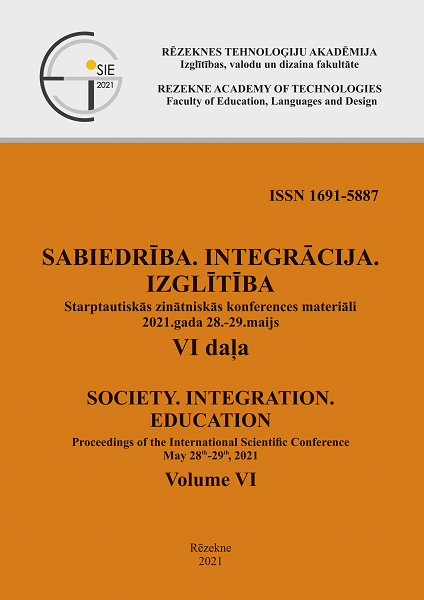THE VOICE OF THE CHILD: AN ANALYSIS OF THE CHILD PROTECTION SYSTEM IN LITHUANIAN FAMILY SOCIAL WORK
DOI:
https://doi.org/10.17770/sie2021vol6.6243Keywords:
child protection, child and family social work, the voice of the childAbstract
This paper explains the current practices of the child welfare system in the context of Lithuania. In Europe, research on child welfare has a long history; however, the child welfare situation in Lithuania has not been systematically studied, nor has it been provided with the research-based knowledge necessary for the development of the system. Based on qualitative research results, the paper sheds light on how the voice of the child is heard in Lithuanian child and family social work practice. The research participants in the present study were children and family social workers. The research results indicate that adult-centered family social work practices are dominant and the voice of the child is misleading in the intervention process.References
Anghel, R., Herczog, M., & Dima, G. (2013). The challenge of reforming child protection in Eastern Europe: The cases of Hungary and Romania. Psychosocial Intervention, 22, 239–249.
Bastian, C. (2020). The child in child protection: Invisible and unheard. Child & Family Social Work, 25(1), 135–143.
Ben-Arieh, A. (2010). From child welfare to children well-being: The child indicators perspective. In S. B. Kamerman, S. Phipps, & A. Ben-Arieh (Eds.), From child welfare to child well-being (pp. 9–22). Springer.
Braun, V., & Clarke, V. (2006). Using thematic analysis in psychology. Qualitative Research in Psychology, 3(2), 77–101.
Bryman, A. (2008). Social research methods (3rd ed.). Oxford University Press.
Caron, F., Plancq, M. C., Tourneux, P., Gouron, R., & Klein, C. (2020). Was child abuse underdetected during the COVID-19 lockdown? Archives de Pédiatrie, 27(7), 399.
Eidukevičiūtė, J. (2013). Family social work practices in the context of transitional Lithuanian society. University of Lapland.
Farmer, E., & Lutman, E. (2010). Case management and outcomes for neglected children returned home to their parents: A five year follow up study. Department for Children, Schools and Families.
Farmer, E., & Owen, M. (1998). Gender and the child protection process. The British Journal of Social Work, 28(4), 545–564.
Ferguson, H. (2017). How children become invisible in child protection work: Findings from research into day-to-day social work practice. The British Journal of Social Work, 47(4), 1007–1023. https://doi.org/10.1093/bjsw/bcw065
Fern, E. (2014). Grown‐ups never understand anything by themselves. Practice, 26(1), 3–22.
Gilbert, N. (2012). A comparative study of child welfare systems: Abstract orientations and concrete results. Children and Youth Services Review, 34, 532–536.
Horwath, J., & Tarr, S. (2015). Child visibility in cases of chronic neglect: Implications for social work practice. The British Journal of Social Work, 45(5), 1379–1394.
Humphreys, K. L., Myint, M. T., & Zeanah, C. H. (2020). Increased risk for family violence during the COVID-19 pandemic. Pediatrics, 146(1).
Israel, M., & Hay, I. (2006). Research ethics for social scientists. Sage.
Jensen, I. B., Studsrød, I., & Ellingsen, I. T. (2020). Child protection social workers’ constructions of children and childhood: An integrative review. Child & Family Social Work, 25, 83–96.
Kahn, A. J. (2010). From “child saving” to “child development.” In S. B. Kamerman, S. Phipps, & A. Ben-Arieh (Eds.), From child welfare to child well-being (pp. 3–8). Springer.
Kelly, L., Hagemann-White, C., Meysen, T., & Römkens, R. (2011). Realising rights: Case studies on state responses to violence against women and children in Europe. London Metropolitan University Ladbroke House.
Koskinen, R. (2014). One step further from detected contradictions in a child welfare unit —a constructive approach to communicate the needs of social work when implementing ICT in social services. European Journal of Social Work, 17(2), 266–280. DOI:10.1080/13691457.2013.802663
Laird, S. E., Morris, K., Archard, P., & Clawson, R. (2017). Working with the whole family: What case files tell us about social work practices. Child & Family Social Work, 22(3), 1322–1329.
Law on Social Services of the Republic of Lithuania. (2006). No. 17-589.
Mason, J. (2007). Qualitative researching. Cromwell Press Limited, Sage Publications.
Motiečienė, R. (2020). Constructing child and family social work discursive practices in the context of Lithuania. University of Lapland.
Ng, G. T. (2005). The rights of the child and the best interests of the child. Asia Pacific Journal of Social Work and Development, 15, 1–4.
Nygren, K., Naujaniene, R., & Nygren, L. (2018). The notion of family in Lithuanian and Swedish social legislation. Social Policy and Society, 17(4), 651–663.
Odinokova, V., & Rusakova, M. (2019). Participation of children in decision-making and their psychosocial wellbeing within the child protection system in St. Petersburg, Russia. Zhurnal Issledovanii Sotsialnoi Politiki=The Journal of Social Policy Studies, 17(4), 643–656.
Peled, E., & Leichtentritt, R. (2002). The ethics of qualitative social work research. Qualitative Social Work, 1, 145–169. https://doi.org/10.1177/147332500200100203
Skinner, C., Bradshaw, J., & Davidson, J. (2007). Child support policy: An international perspective. Corporate Document Services.
The United Nations. (1989). The United Nations Convention on the Rights of Children.
Toros, K. (2017). Child protective workers’ reflections on principles underpinning the assessment of children in need: The case of Estonia. International Social Work, 60(5), 1255–1267.
White, S. (2003). The social workers as moral judge: Blame, responsibility and case formulation. In Ch. Hall, K. Juhila, N. Parton, & T. Pösö (Eds.), Constructing clienthood in social work and human services: Interaction, identities, and practices (pp.177–192). Jessica Kingsley Publishers.






